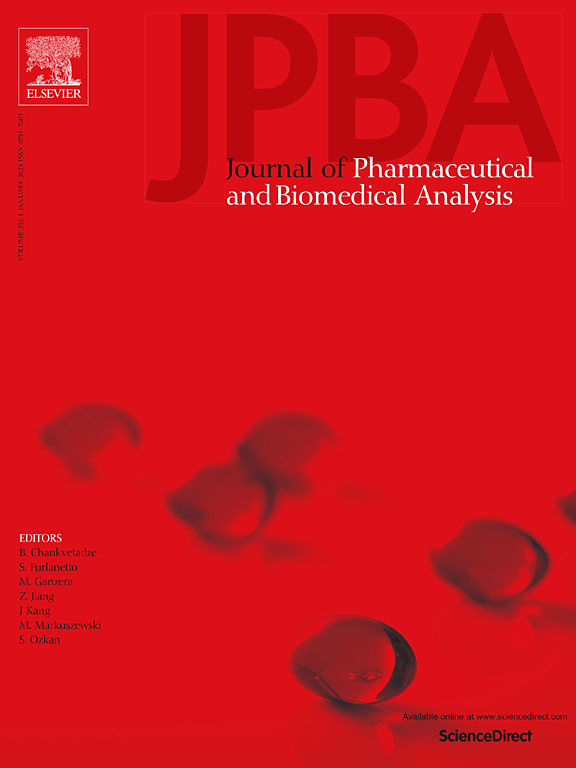A validated single-step saliva and serum sample extraction LC-MS/MS method for the analysis of nicotine, cotinine and 3’-hydroxycotinine for clinical vaping studies
IF 3.1
3区 医学
Q2 CHEMISTRY, ANALYTICAL
Journal of pharmaceutical and biomedical analysis
Pub Date : 2025-01-27
DOI:10.1016/j.jpba.2025.116703
引用次数: 0
Abstract
Introduction
Quantifying low nicotine and metabolite concentrations in biofluids is challenging due environmental nicotine contamination. However, accurate quantification of low concentrations is crucial for studies on electronic nicotine delivery systems (ENDS) using e-liquids with varying nicotine content.
Methods
We developed an LC-MS/MS method to quantify nicotine, cotinine, and 3’-hydroxycotinine (3-OH-cotinine) in serum and saliva for pharmacokinetic (PK) analyses and large studies.
Results
For reliable chromatography and to limit bench work, C18 chromatography was used with single-step extraction using methanol and 0.1 M ZnSO4 (4:1, v/v) in serum and 80 % methanol in saliva. Environmental nicotine contamination was addressed through implementation of a C18 delay column, which separated the environmentally abundant nicotine present in the mobile phases from sample nicotine peaks. Total run-time was 6 min and lower limits of quantification were 0.5, 0.25 and 0.5 ng/ml for nicotine, cotinine and 3-OH-cotinine, respectively, in serum and 3, 1 and 2 ng/ml in saliva. The standard curves in both biofluids ranged up to 1000 ng/ml with R-values > 0.995. The within- and between-run accuracy ranged from 97.1 % to 106.9 % with a precision of ≤ 10.8 %. Cross-validation of serum samples with another laboratory showed good agreement with a bias of 0.56, −3.0 and −6.5 ng/ml for nicotine, cotinine and 3-OH-cotinine, respectively.
Conclusions
The integration of a delay column into the LC-MS/MS method mitigated the interference from environmental nicotine and facilitated the quantification of very low nicotine concentrations and two of its major metabolites in saliva and serum. C18 chromatography and single-step sample extraction make the method stable and suitable for large sample loads.
求助全文
约1分钟内获得全文
求助全文
来源期刊
CiteScore
6.70
自引率
5.90%
发文量
588
审稿时长
37 days
期刊介绍:
This journal is an international medium directed towards the needs of academic, clinical, government and industrial analysis by publishing original research reports and critical reviews on pharmaceutical and biomedical analysis. It covers the interdisciplinary aspects of analysis in the pharmaceutical, biomedical and clinical sciences, including developments in analytical methodology, instrumentation, computation and interpretation. Submissions on novel applications focusing on drug purity and stability studies, pharmacokinetics, therapeutic monitoring, metabolic profiling; drug-related aspects of analytical biochemistry and forensic toxicology; quality assurance in the pharmaceutical industry are also welcome.
Studies from areas of well established and poorly selective methods, such as UV-VIS spectrophotometry (including derivative and multi-wavelength measurements), basic electroanalytical (potentiometric, polarographic and voltammetric) methods, fluorimetry, flow-injection analysis, etc. are accepted for publication in exceptional cases only, if a unique and substantial advantage over presently known systems is demonstrated. The same applies to the assay of simple drug formulations by any kind of methods and the determination of drugs in biological samples based merely on spiked samples. Drug purity/stability studies should contain information on the structure elucidation of the impurities/degradants.

 求助内容:
求助内容: 应助结果提醒方式:
应助结果提醒方式:


